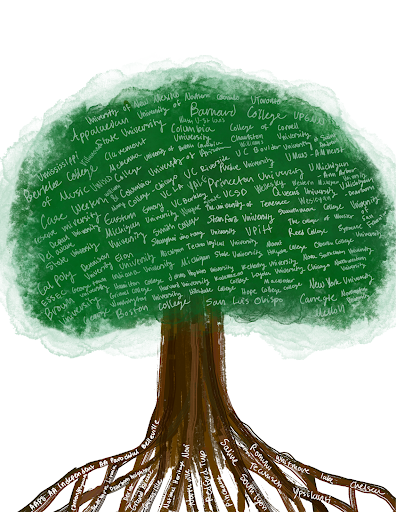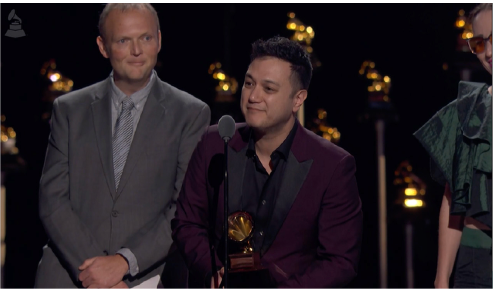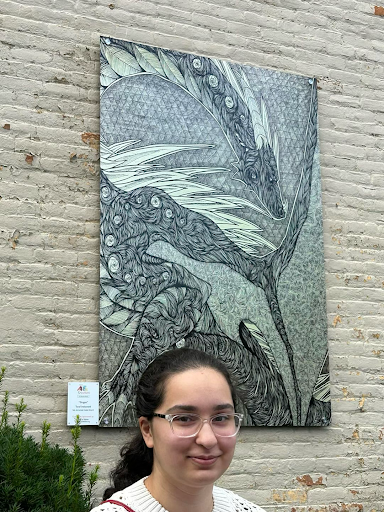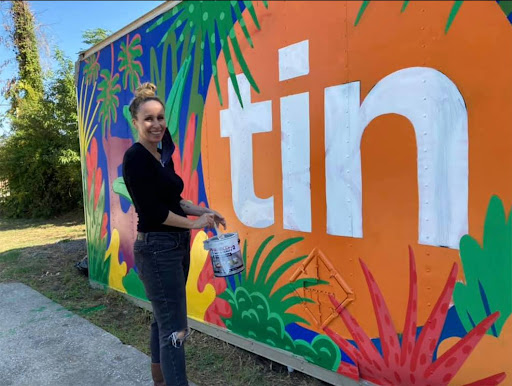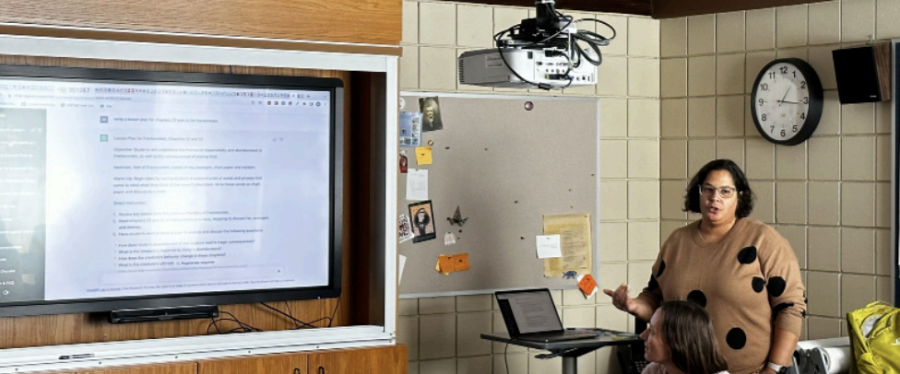School begins to navigate ChatGPT
With academic honesty concerns, school focuses on AI tech, responsible usage
IT DOES WHAT NOW? Teachers got together for meetings on Jan 26 to learn about the new Ai ChatGPT. “The main purpose for this meeting was to show teachers what ChatGPT can do and how they can use the bot to their advantage. It’s very exciting as it might take teaching to a whole new level,” said English teacher Monica Lewis.
March 2, 2023
With just a few lines of instructions, OpenAI’s ChatGPT can write anything you ask it to within seconds. Unlike search engines like Google, when you ask ChatGPT a question, it does not give you thousands of links that have the answer., Instead, it returns the answer in clear, easy-to-understand words. What’s more, ChatGPT can code in multiple languages and generate own ideas from scratch; it can write an email telling one’s boss why they won’t make it to work, it can help one make a presentation; it can even make a workout plan.
Many students have begun to use ChatGPT at the school, and have spent some time testing its capabilities. Raj Tiller ‘23 spent over 10 hours coding his own version of minesweeper in Java Script. After many iterations and tweaks, he was able to get the code working. However, when he and fellow computer science classmate Adrian Bardwell ‘23 asked ChatGPT to code it, it took the bot just a few minutes to write the whole code.
“Minesweeper was really hard to code, with just my basic understanding of computer science I knew it was always going to be tough,” said Tiller. “I was really satisfied when I got it to work though, and it was worth the effort.”
Tiller found the project to be useful. It was something he himself was interested in doing and spent his own time doing it. He felt it strengthened his understanding in computer science and helped him learn new concepts.
“It was definitely surprising to see ChatGPT just code the same game in five minutes. It did what took Raj a few hours in just a few minutes,” said Bardwell. “Sure, it did have a few hiccups at the beginning, but I kept feeding the bot more information about the code and it just kept coding it.”
The bot’s code had errors when it first coded it, and at times, it wouldn’t run as expected.
“The first time I tried to run ChatGPT’s code, it didn’t create the game exactly how I wanted it to and ran into some errors. However, what I did was plug the code back into the bot and told it to fix the code. Within a few seconds, it gave me a corrected version of the code,” said Bardwell.
The school does have concerns that students may use the bot in ways that may be considered academically dishonest. To understand more about the bot and how teachers can use it to their advantage, the faculty conducted meetings throughout the day on Jan. 26.
“These meetings were the first of a series of meetings that we plan on having,” said English teacher Monica Lewis. “The first meeting was mainly to show teachers the capability of ChatGPT and how they can use it to their own advantage.”
The teachers spent time using the bot together and asked it to do multiple tasks, such as coming up with lesson plans and writing emails.
“We wanted to show the teachers not only what the bot is capable of but also what its limitations are. When we asked the bot to come up with lesson plans, it came up with them, but they definitely weren’t great,” said Lewis.
The teachers also talked about how they can see if the students are using the bot to get all of their work done.
“It’s pretty easy to tell if a student is using ChatGPT or not because of how generic the answers are, since a robot does not provide a lot of detail or voice in the essays, ” said Lewis. “The best way to prevent this type of cheating is to assign homework that asks very deep and specific questions. This way the bot won’t be able to answer the question.”
Economics teacher Alexander Monte-Sano has played around with the bot since its release and has found some uses with it.
“The first thing I asked the bot to do was solve this complex math problem. However, it was not able to solve the problem I had asked it,” said Monte-Sano. “But I played around with it more and I asked it to make me a lesson plan for my economics class. It did produce a pretty generic lesson plan, but still, it did give me something which is impressive.”
Monte-Sano has also asked the bot more specific questions to see if it could come up with responses.
“I asked the bot to find me clips from different TV shows for some of the topics we were going over in micro economics, it gave me 10 different clips from different shows, however all of the links were out dated and had been taken off of YouTube,” said Monte-Sano.
Monte-Sano has also worked with students to help them use the bot to their advantage but not using it to the point where it would be considered academically dishonest.
“A student had to give a presentation on the major economic events of the 1960s, if they used Google to search for this question, they would get multiple links with the information, and then have to synthesize it a bit by themselves, with ChatGPT however it is able to synthesize the information and make it clearer for the student,” said Monte-Sano. “I personally believe it’s better for students if they are able to get rid of the boring things and are able to focus more of their time on the higher level thinking aspect of the project.”
ChatGPT can be used responsibly by students, there are many advantages to using the bot. Spanish teacher Jennifer Gray said when Google Translate first came out language teachers were put in a similar situation.
“When Google Translate first came out, my first reaction was, ‘am I out of a job?’” said Gray.
It was a real concern for language teachers on how they would teach students, because now they could do their language assignments with just a few clicks of a button.
“Students could just use Google Translate now to do all of their work, anything I would assign as homework could be done on a computer,” said Gray. “However, there were a lot of things that students weren’t learning when they just used Google Translate, they weren’t learning how to speak the language fluently and they weren’t learning about the culture of the language they were learning, there were still a lot of things they were learning in class that Google Translate couldn’t teach them.”
It was also very easy for Gray to tell when students were using Google Translate to complete an assignment.
“When students had words that we had never learned or were using grammar techniques that were far too advanced for them, I was able to tell that they were using translation,” said Gray. “To stop this I could just make all of their test translations written on paper, where they would struggle without Google.”
However, Gray did not want to run her class like this, she did not want to constantly be checking to see if they were cheating on an assignment or not.
“I didn’t want my job to be me policing everyone and trying to figure out if they were cheating or not, instead I had several discussions with my students regarding the use of Google Translate,” said Gray. “Google Translate can be used as a tool, if you forget a few words and are blanking on their meaning, you can use Google Translate to help you figure out the meaning.”
In a similar way students can learn how to use ChatGPT as a tool that helps them study and helps them get their work done rather than use it to cheat on their assignments. ChatGPT and other AI’s will only get better as time goes on, and more and more people will use them, however these AI’s cannot replace what is taught in a classroom. Teachers will have to use AI checkers to catch cheating, but the job a teacher does cannot be replaced by one of these AI’s; yet.



